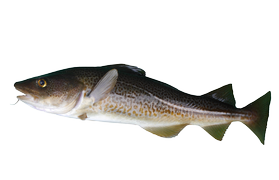
COD
All members of the cod family have three dorsal fins and two anal fins. Cod is the largest in the family and is identified by its overbite, barbels and a light lateral line. The color varies considerably depending on habits, feed and the conditions on the sea bed.
Skrei is a mature Arctic cod which migrates and is caught down the coast of Norway from January to April.
Fish facts
All the parts of a large cod can be used, including the cheeks, tongue and carcass. The back, the thickest part of a larger fish, is the best part.
A small sized cod might actually be another species, a Poor cod or Pouting.
Cooking cod
Cod has beautiful white flesh but a mild flavor which makes it suited for practically everything apart from the grill as it falls apart easily. One way of improving the consistency of cod and drawing out an even better taste experience is to lightly salt it before boiling or frying. Salt portion-sized pieces for about 30 minutes in a 10% brine (100 ml salt to 1 liter of water).
Thick parts of cod taste better and are easier to handle too after soaking in brine. Don’t forget to dry them off before carefully placing in a hot pan once the butter has stopped spluttering. Don’t fry too much fish at a time. About two back fillets in a medium-sized pan ought to work. Adjust the temperature to retain the heat but without burning the butter. Baste with the butter and turn the pieces carefully with two fish slices.
If you are frying cod back fillets completely in the pan, there is a risk that the outside will be over-cooked. Fry to an internal temperature of about 40°C – and a beautifully browned surface on both sides – and leave to cook the final bit – to just under 50°C – in a warm oven. If you put the whole pan in the oven, you avoid unnecessarily handling the fish.
“The fish is done on the way out to the customer" is a saying from the professionals, and it’s certainly true of a perfect piece of cod. It should fall into slices following the structure of the flesh with the help of nothing but a fork, the meaty slices should be perfectly al dente and the center should look like mother of pearl.
Coating is another good way of adding flavor and stopping the flesh falling apart in the pan.
Simmer/poach cod carefully so it doesn’t disintegrate in the liquid. Use a thermometer and stop the process before the flesh has gone dull and dry. If you are cooking soup, add pieces of cod at the end so it doesn’t boil dry and doesn’t fall apart.
The classic
Boiled cod, or a carefully fried cod fillet, with melted butter and freshly grated horseradish.
Conservation status:
Organic and MSC-labelled cod, Atlantic cod, Norwegian skrei, and cod from the eastern Baltic has green status. A cod at the fishmongers shouldn’t be shorter than 50 cm (fillet approx. 30 cm).








